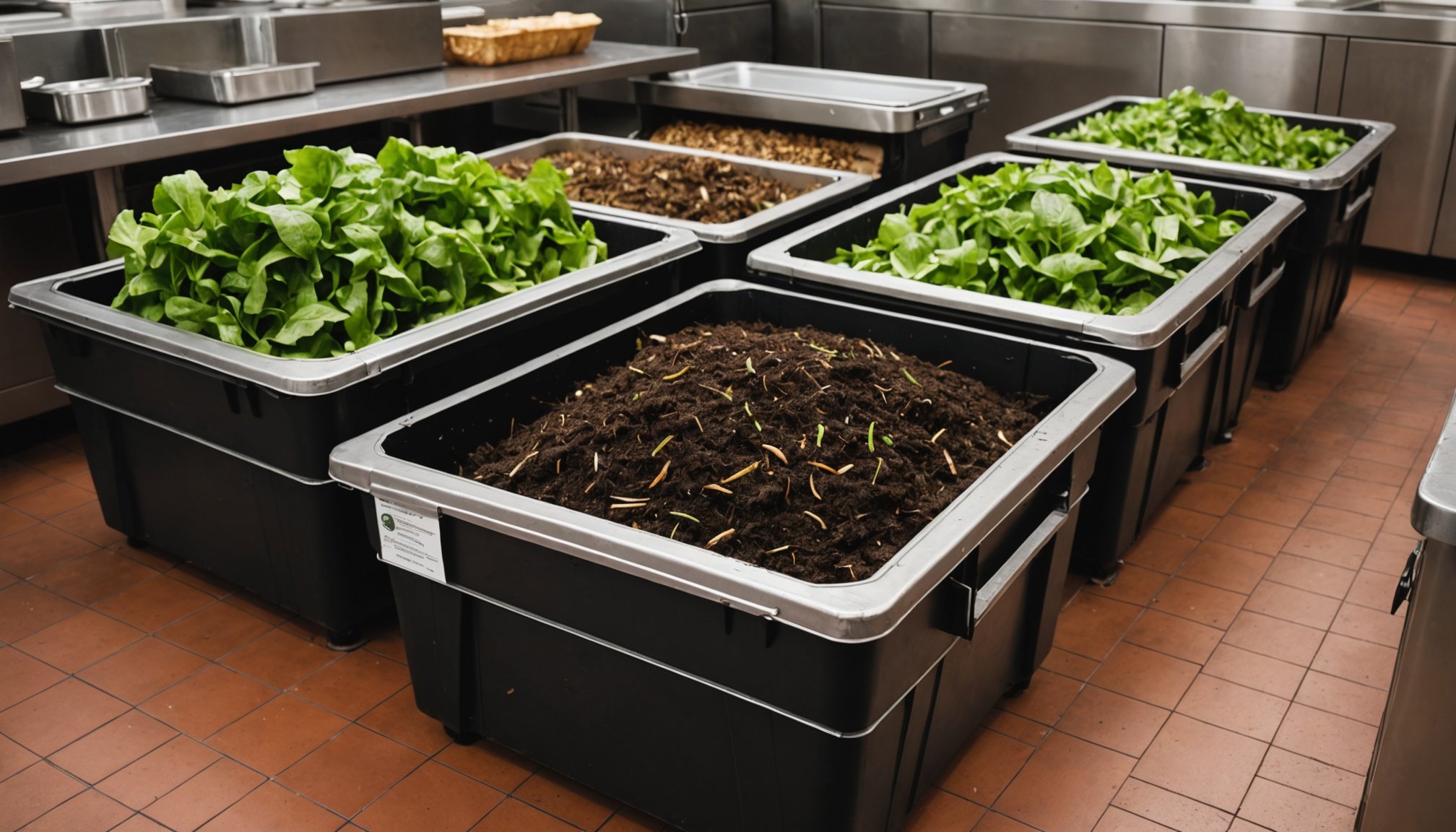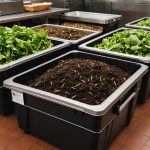Turning table scraps into treasure can transform your restaurant's waste management while enhancing sustainability. Implementing an organic waste composting system not only reduces landfill contributions but also enriches your community and generates valuable compost for local gardens. This guide offers practical steps, tips, and insights to create an effective composting program tailored to your restaurant's unique needs. Embrace the potential of organic waste and discover how it can benefit your establishment and the environment.
Understanding Organic Waste Composting in Restaurants
Organic waste composting is a sustainable practice that transforms food scraps and other biodegradable materials into nutrient-rich compost. This process is crucial for effective waste management in restaurants, helping to reduce the volume of waste sent to landfills. By adopting organic waste composting, restaurants can significantly lower their environmental footprint.
Also read : Essential Actions Restaurants Must Take to Achieve Food Traceability Compliance
Restaurant composting benefits are manifold. Firstly, it reduces waste disposal costs, as less waste means fewer pickups and smaller landfill charges. Secondly, it enhances a restaurant's public image by showcasing a commitment to sustainability, which can attract eco-conscious customers. Additionally, the compost produced can be used to enrich soil in community gardens or even on-site if the restaurant has a garden.
The environmental impact of composting is substantial. Organic waste in landfills decomposes anaerobically, releasing methane, a potent greenhouse gas. Composting, on the other hand, occurs aerobically, minimizing methane emissions and promoting carbon sequestration. Furthermore, the resulting compost improves soil health, enhancing its ability to retain water and nutrients, thus supporting sustainable agriculture.
Also to discover : Create a unique signature cocktail to enhance your bar”s brand identity
In summary, organic waste composting in restaurants is not just a waste management strategy; it's a step towards a more sustainable and environmentally friendly operation.
Step-by-Step Guide to Setting Up a Composting System
Setting up a composting system in a restaurant involves several key steps to ensure efficiency and effectiveness. Begin by assessing the type of organic waste your restaurant generates. This includes kitchen scraps, coffee grounds, and biodegradable packaging. Understanding the waste profile is crucial for selecting the most suitable composting method.
Choosing the Right Composting Method
Selecting the appropriate composting process is vital. Options include:
- In-vessel composting: Ideal for restaurants with limited space, this method uses enclosed containers to control temperature and moisture, accelerating decomposition.
- Pile composting: Suitable for establishments with outdoor space, this traditional method involves stacking organic waste in piles, requiring regular turning to aerate.
- Worm composting (vermicomposting): Uses worms to break down waste, producing nutrient-rich compost. It's a great option for smaller-scale operations.
Installation and Setup Instructions
Once the method is chosen, follow these steps:
- Designate a specific area for composting, ensuring it's accessible and well-ventilated.
- Acquire necessary equipment, such as bins or containers, based on the chosen method.
- Educate staff on sorting waste and maintaining the composting system.
- Regularly monitor and adjust the composting process, ensuring optimal conditions for decomposition.
Best Practices for Managing a Composting System
Efficient compost management is essential for successful organic waste processing in restaurants. Regular monitoring is key to maintaining a healthy composting system. This involves checking temperature, moisture levels, and aeration to ensure optimal decomposition. If the compost is too dry, add water; if it's too wet, incorporate more dry materials like leaves or shredded paper.
Balancing carbon and nitrogen materials is crucial for effective composting. Carbon-rich materials, such as dried leaves and paper, should be combined with nitrogen-rich waste, like kitchen scraps, to create a balanced mix. A general rule of thumb is to maintain a ratio of about 30 parts carbon to 1 part nitrogen. This balance ensures that microorganisms can efficiently break down the waste.
Troubleshooting common composting issues is part of effective compost maintenance. If the compost emits an unpleasant odour, it may be too wet or lack sufficient aeration. Turn the pile and add dry materials to resolve this. If decomposition is slow, the pile might need more nitrogen-rich materials or better aeration. Regularly addressing these issues will keep the composting process smooth and efficient.
Case Studies of Successful Restaurant Composting
Exploring restaurant composting case studies provides valuable insights into effective industry practices. One notable example is a popular bistro in San Francisco that embraced composting to tackle food waste. By integrating an in-vessel composting system, the bistro managed to reduce its waste by 60% within a year. This significant waste reduction not only decreased landfill contributions but also resulted in substantial cost savings on waste disposal.
Another inspiring case is a family-owned café in Portland. They adopted worm composting to manage kitchen scraps and coffee grounds. This method proved to be cost-effective and suitable for their smaller operation. The café not only reduced waste disposal costs but also used the nutrient-rich compost to enhance their own herb garden, creating a closed-loop system.
Lessons learned from these successful examples highlight the importance of staff training and regular monitoring. Ensuring employees understand the composting process and its benefits fosters a culture of sustainability. Additionally, these case studies demonstrate that composting can significantly enhance a restaurant's public image, attracting eco-conscious patrons and boosting customer loyalty. By adopting successful industry practices, restaurants can achieve both environmental and economic benefits, making composting a viable and sustainable choice.
Overcoming Challenges in Restaurant Composting
Navigating composting challenges in restaurants can be daunting, yet identifying these hurdles is the first step towards effective solutions. One common issue is the waste management obstacles posed by limited space. Restaurants often struggle to find adequate areas for composting systems. To tackle this, consider compact solutions like in-vessel composting, which require minimal space and offer efficient decomposition.
Another challenge is ensuring consistent participation from staff. Employee engagement is crucial for successful composting. Implementing comprehensive staff training programs can foster a culture of sustainability. Training sessions should cover waste sorting, system maintenance, and the environmental benefits of composting. Engaged staff are more likely to adhere to composting protocols, ensuring smoother operations.
Restaurants may also face difficulties with compost quality due to improper waste segregation. A practical solution is to establish clear guidelines for waste separation, complemented by regular monitoring. This ensures that only suitable materials enter the composting system, enhancing the quality of the final product.
By addressing these composting challenges with tailored solutions, restaurants can optimise their waste management processes, reinforcing their commitment to sustainability and environmental responsibility.
Environmental Benefits of Composting for Restaurants
Composting offers significant environmental benefits for restaurants, contributing to a more sustainable industry. By reducing landfill waste, restaurants can decrease their greenhouse gas emissions, particularly methane, which is a potent contributor to climate change. This shift not only lessens the environmental impact of waste management but also aligns with broader goals of sustainability in restaurants.
Embracing eco-friendly practices through composting supports sustainable food systems and local agriculture. The nutrient-rich compost produced can be used to fertilize gardens, thereby closing the loop in food production and consumption. This practice enhances soil health, promoting biodiversity and reducing the need for chemical fertilizers.
Moreover, implementing composting initiatives can enhance a restaurant's reputation. As consumers become increasingly eco-conscious, demonstrating a commitment to sustainability can attract a wider customer base. By adopting composting as part of their eco-friendly initiatives, restaurants can differentiate themselves in a competitive market.
In summary, the environmental impact of composting is multifaceted, offering benefits that extend beyond waste reduction. It fosters a sustainable approach to food waste management, supports local agriculture, and enhances the public image of restaurants committed to eco-friendly practices.
Cost Savings Associated with Composting
Implementing composting systems in restaurants offers significant cost benefits. One primary advantage is the reduction in waste disposal costs. By diverting organic waste from landfills, restaurants can decrease the frequency and volume of waste pickups, leading to lower disposal fees. This immediate reduction in costs can be substantial, particularly for establishments generating large amounts of organic waste.
Beyond immediate savings, composting provides long-term financial benefits. Investing in composting systems can enhance a restaurant's sustainability profile, potentially attracting more eco-conscious customers. Over time, this can lead to increased patronage and revenue. Additionally, the nutrient-rich compost produced can be used to support on-site gardens, reducing the need for purchasing external fertilizers.
Restaurants can also explore various funding opportunities or incentives to offset the initial investment in composting systems. Many local governments and environmental organizations offer grants or tax incentives to businesses adopting sustainable practices. By leveraging these resources, restaurants can further enhance their financial savings while contributing positively to the environment.
In summary, the financial savings from composting are multifaceted, offering both immediate and long-term benefits while supporting a sustainable business model.
Resources and Tools for Implementing Composting
When setting up a composting system in restaurants, having the right composting resources and tools is essential. Several products can streamline the process, ensuring efficiency and effectiveness. Key tools include compost bins, which come in a variety of sizes and types to fit different needs. Aerators are vital for maintaining proper air circulation, while thermometers help monitor temperature for optimal decomposition.
For those new to composting, downloadable guides provide step-by-step instructions and tips. These guides are often available from environmental organizations and offer practical advice tailored to the restaurant industry. They cover everything from selecting the right composting method to troubleshooting common issues.
Visual aids, such as infographics and videos, are also valuable for engaging staff and simplifying the learning process. These tools can illustrate the benefits of composting and demonstrate proper waste sorting techniques.
Additionally, numerous organizations offer support and resources to help restaurants implement composting. They provide access to downloadable content, workshops, and expert advice. By leveraging these resources, restaurants can efficiently integrate composting into their operations, enhancing both sustainability and waste management practices.











